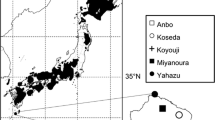Abstract
Food habits of sika deer,Cervus nippon centralis temminck, in Mt. Ohdaigahara, central Japan, were investigated by the fecal analysis method from September, 1990, to June, 1991. The fecal analysis showed that the percentage ofSasa nipponica Makino et Shibata in the fecal composition was approximately 50% throughout the year, indicating that it was the main food plant. Bark and twigs were also found in the feces in all seasons, suggesting that the deer ate bark throughout the year. Even though the amount of the bark eaten per capita was small, the high density of deer may possibly cause serious bark damage. Barking can be one of the main causes of the mortality ofPicea jezoensis Sieb. et Zucc. var.hondoensis (Mayr) Rehder andAbies homolepis Sieb. et Zucc. in Mt. Ohdaigahara.
Similar content being viewed by others
Literature cited
Anthony, R.G. and Smith, N.S. (1974) Comparison of rumen and fecal analysis to describe deer diets. J. Wildl. Manage. 38: 535–540.
Doei, T. and Suganuma, T. (1987) Ecological studies on dynamics ofPicea jezoensis var.hondoensis forest on Mt. Ohdaigahara, Central Japan, (1). Nara Bot. 10: 31–35. (in Japanese)
Doei, T., Doei, H., and Suganuma, T. (1989) Flora of the summit area of Mt. Ohdaigahara, in the Kii Peninsula, Central Honshu, Japan, I. Nanki Biol. 31: 13–18. (in Japanese)
Fahn, A. (1990) Plant Anatomy. 4th ed. 588pp. Pergamon Press, Oxford.
Fukushima, N., Miura, S., Kikuchi, Y., Maruyama, N. and Tanaka, H. (1984) Density of Sika deer (Cervus nippon) on the summit area of Mt. Ohdaigahara.In A report on the floral change and its management in Mt. Ohdaigahara. 50 pp. Nara Natural Environment Society, Nara, 29–37. (in Japanese)
Gill, R.M.A. (1992) A review of damage by mammals in north temperate forests: 1. deer. Forestry 65: 145–169.
Horino, S. and Kuwahata, T. (1986) Food habits of Japanese serow (Capricorniscrispus) and Japanese deer (Cervus nippon) in a cohabitat. Bull. For. & For. Prod. Res. Inst. 341: 47–61.
Hoshino, Y., Jida, N., and Maruyama, N. (1987) Impacts of sika deer and Japanese black bears on the spruce forests in Ohdaigahara.In Papers on plant ecology and taxonomy to the memory of Dr. Satoshi Nakanishi. 367–377. (in Japanese with English summary)
Ide, H. and Kameyama, A. (1972) Vegetation of Odaigahara. Appl. Bot. Sociol. 1: 1–48. (in Japanese)
Kaji, K., Koizumi, T., and Ohtaishi, N. (1988) Effects of resource limitation on the physical and reproductive condition of sika deer on Nakanoshima Island, Hokkaido, Acta Theriol. 33: 187–208.
Kessler, W.B., Kasworm, W.F., and Bodie, W.L. (1981) Three methods compared for analysis of pronghorn diets. J. Wildl. Manage. 45: 612–619.
Kikuchi, Y., Maruyama, N., Miura, S., and Fukushima, N. (1984)Sasa nipponica as a forage of sika deer (Cervus nippon) on Mt. Ohdaigahara.In A report on the floral change and its management in Mt. Ohdaigahara. 50 pp. Nara Natural Environmental Society, Nara, 47–48. (in Japanese)
Koizumi, T., Shibata, E., and Tabata, K. (1994) Inhabiting conditions of sika deer population on Mt. Ohdaigahara.In The report of conservation of the spruce forest on Mt. Ohdaigahara (1989–1993). 74 pp. Environmental Agency, Tokyo, 35–42. (in Japanese)
McIntyre, E.B. (1972) Barkstripping — a natural phenomenon. Scott. For. 26: 43–50.
Sekine, T. and Sato, H (1992) Tree barking by sika deer,Cervus nippon Temminck, on Mt. Odaigahara. Jpn. J. Ecol. 42: 241–248. (in Japanese with English summary)
Shibata, E., Katayama, N., and Kataoka, H. (1984) Damage to conifers by the sika deer (Cervus nippon) on Mt. Odaigahara, Nara Bot. 7: 1–6. (in Japanese)
Shigematsu, Y. (1985) Cells of bark.In Structure of timber. Shimaji, K., Saeki, H., Harada, H., Shiokura, T., Ishida, S., Shigematsu, Y., and Sudoh, S. (eds.), 276pp, Buneido, Tokyo, 207–216. (in Japanese)
Stewart, D.R.M. (1967) Analysis of plant epidermis in faeces: a technique for studying the food preferences of grazing herbivores. J. Appl. Ecol. 4: 83–111.
Takatsuki, S. (1978) Precision of fecal analysis: a feeding experiment with penned sika deer. J. Mamm. Soc. Jpn. 7: 167–180.
Takatsuki, S. (1980) Food habits of sika deer on Kinkazan Island. Sci. Rep. Tohoku Univ. Ser. IV (Biol.) 38: 7–31.
Takatsuki, S. (1983) The importance ofSasa nipponica as a forage for sika deer (Cervus nippon) in Omote-Nikko. Jpn. J. Ecol. 33: 17–25.
Takatsuki, S. (1986) Food habits of sika deer on Mt. Goyo, northern Honshu. Ecol. Res. 1: 119–128.
Takatsuki, S. (1990) Summer dietary compositions of sika deer on Yakushima Island, southern Japan. Ecol. Res. 5: 253–260.
Takatsuki, S. and Ikeda, S. (1993) Botanical and chemical composition of rumen contents of sika deer on Mt Goyo, northern Japan. Ecol. Res. 8: 57–64.
Takatsuki, S., Kawahara, H., and Torisu, C. (1984) Fecal analysis of sika deer on Nozaki Island, the Goto Islands, northwestern Kyushu. Ann. Rept. Nagasaki Sogo Univ. 25: 37–43. (in Japanese)
Todd, J.W. and Hansen, R.M. (1973) Plant fragments in the feces of bighorns as indicators of food habits. J. Wildl. Manage. 37: 363–366.
Wada, R. (1990) The effects of sika deer (Cervus nippon) on population ofSasa nipponica in Mt. Ohdaigahara. 40 pp, Master's Thesis of Nara Women's University, Nara. (in Japanese)
Welch, D., Staines, B.W., Scott, D., and Catt, D.C. (1987) Bark stripping damage by red deer in a Sitka spruce forest in Western Scotland. I. Incidence. Forestry 60: 249–262.
Author information
Authors and Affiliations
About this article
Cite this article
Yokoyama, S., Koizumi, T. & Shibata, E. Food habits of sika deer as assessed by fecal analysis in Mt. Ohdaigahara, central Japan. J. For. Res. 1, 161–164 (1996). https://doi.org/10.1007/BF02348195
Accepted:
Issue Date:
DOI: https://doi.org/10.1007/BF02348195




